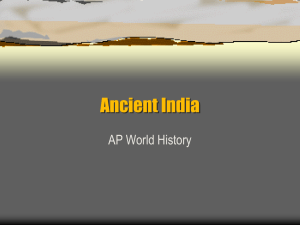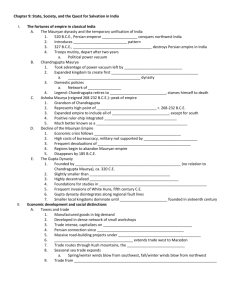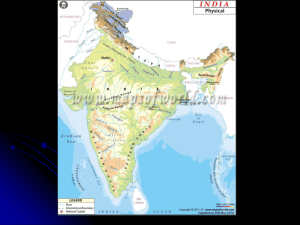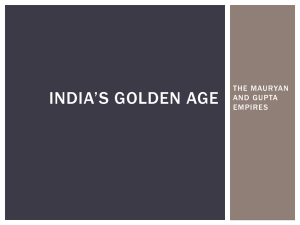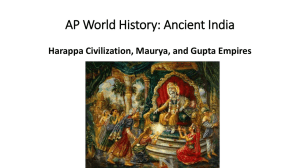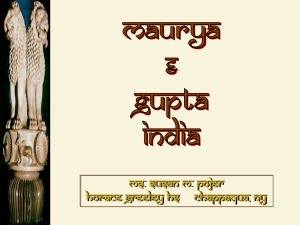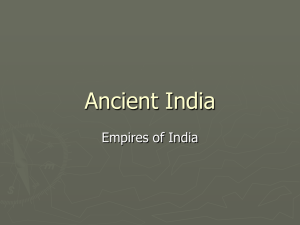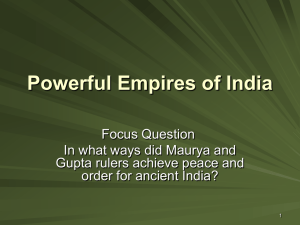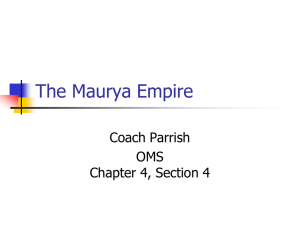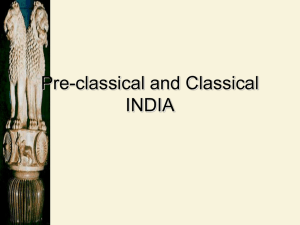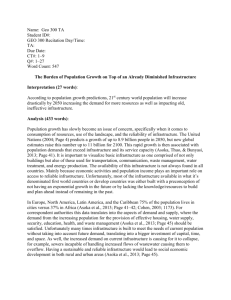Indian Empires
advertisement
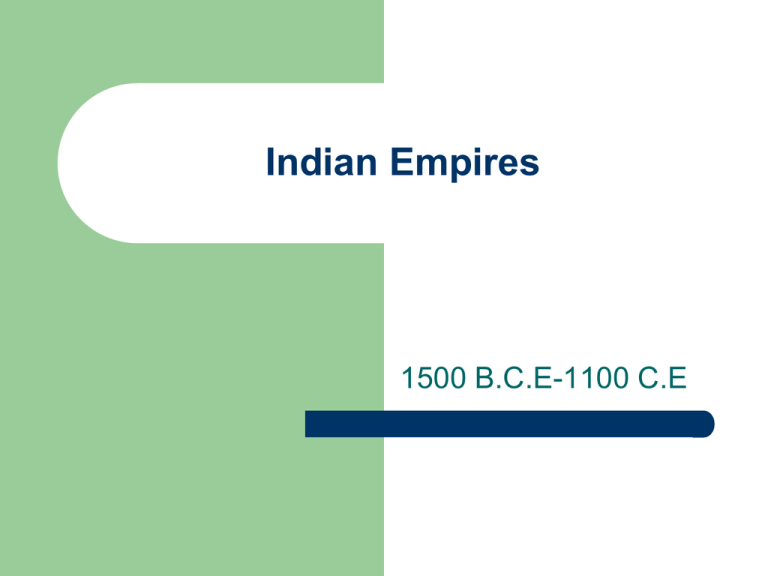
Indian Empires 1500 B.C.E-1100 C.E Unified India? Diverse India dating to 3000 B.C.E Never has India been unified—British came close (lacked Afghanistan, then part of India) Closest person? Asoka Maurya, lacked parts of the South Difficult to do, India is ½ the size of the European continent Disintegration Harappan civilization came to a close around 1500 B.C.E Reasons still uncertain Blended with aryans. Emergence of Janapadas (populated territories) India’s revolving door Persian conquest—500-400 B.C.E Alexander the Great—326 B.C.E Chandragupta Maurya Conqueror from the “janapada” of Mahadha known as Chandragupta Maurya expanded into NW India. His son—Bindusara Gupta (297-272 B.C.E) conquered even further South. Emerging from this is the greatest ruler of classical India—Asoka Maurya (265-238 B.C.E) Asoka’s Empire Stretched from Afghanistan to the Bay of Bengal in the East to the Deccan Peninsula in the South. Ruled over an estimated 100,000,000 peple Statecraft of the Maurya Expressed in the Arthasastra (Arthashastra) Kautilya: wrote of the policy of danda niti—policy of the scepter, the policy of the big stick. Cut throat view of politics. “Justice of the Fish” The enemy of my enemy is my friend. Development of Caste The caste system had been in place since Aryan/Harappan times. It has been ever expansive. This system not only governs someone’s social, economic, and ritual position which was inherited directly from birth it also provides unequal protection under laws. The Arthashastra provided that the state m ust enforce caste distinctions. Excerpts “If a king is energetic, his subjects will be equally energetic. If he is reckless, they will not only be reckless likewise, but also eat into his works. Besides, a reckless king will easily fall into the hands of his enemies” "In the happiness of his subjects lies the king's happiness, in their welfare his welfare. He shall not consider as good only that which pleases him but treat as beneficial to him whatever pleases his subjects" “The king shall provide the orphans, the aged, the infirm, the afflicted, and the helpless with maintenance. He shall also provide subsistence to helpless women when they are carrying and also to the children they give birth to.” Extent of Mauryan control Regulated nearly everything including religion. Namely Hindu/Buddhist monstaries. Regulated Indian guilds Utilized ministers and a secret police. Asoka and Kalinga Victory changes a heart Asoka and “ahimsa” Missionary efforts Monasteries and Stupas Rock and Pillar Edicts The sixth rock and pillar edit I consider that I must promote the wealfare of the whole world, and hard work and the dispatch of business are the means of doing so. Indeed there is no better work than promoting the welfare of the whole world. And whatever may be great deeds, I have done them in order to discharge my debt to all beings” The Demise of Mauryan India Ruled by regional kingdoms and nomadic invaders after Asokas death. Most lasting the Kushanas. Great Kushan ruler— Kanishka similar to Asoka in his promotion of Buddhism. Gupta India Founded by Chandra Gupta Signature ruler Samudra Gupta—the great military leader of Ancient India. Gupta “Federalism” Often ruled indirectly. Demanded only tribute Much smaller than the Mauryan Gupta Renaissance Age of brilliant literature and philosophy Kalidassa—the brilliant poet Sanskrit formalized as a language Hindu resurgence Vedanta Upanishads Clarification of earlier teachings Led to strengthening of Caste Demise of the Buddhist faith in India Gupta Demise—the Hunas (Huns) Huna impact on India=profound. Nomadic invaders who trace roots to Mongols. Ravaged much of Asia in the 5th century C.E Destroyed Guptas Attacked Buddhists Stopped international trade Led to a return of regional kingdoms.
